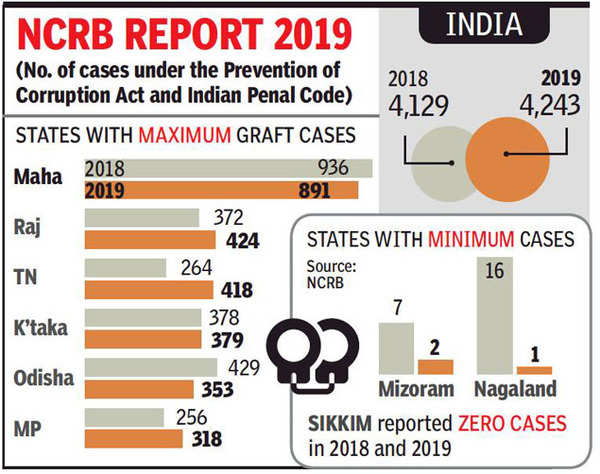- News
- City News
- mumbai News
- Maharashtra leads in graft cases for 3rd year in row, but logs 15% conviction rate
Trending
This story is from October 5, 2020
Maharashtra leads in graft cases for 3rd year in row, but logs 15% conviction rate
Maharashtra has reported the highest number of corruption cases against public servants for three years in a row, from 2017 to 2019.

Representative image
MUMBAI: Maharashtra has reported the highest number of corruption cases against public servants for three years in a row, from 2017 to 2019.
According to the latest data released by the National Crime Records Bureau (NCRB), 891 graft cases were reported in Maharashtra in 2019; Rajasthan came a distant second with 424 cases. The conviction rate in Maharashtra, however, has been a measly 15% in both 2018 and 2019.

The north-eastern states of Sikkim, Mizoram and Nagaland reported the least number of corruption cases—zero, two and one, respectively—in 2019. But former Maharashtra ACB chief Pravin Dixit pointed out that just because a state reports fewer corruption cases does not necessarily mean its public servants are honest. “There’s a possibility that the people might not be sufficiently aware. The Maharashtra ACB has publicised its website, app and helpline. Online complaints are also recorded. People believe their grievance would be heard,” he added.
The low conviction rate in Maharashtra is a result of delay in cases coming up for trial and quality of investigation found lacking, said legal eagles. “The most crucial part in a corruption case is establishing that there was a demand for money. Merely nabbing a public servant with currency is not enough,” said advocate VN Shinganapurkar. “The panchnama should record the exact sequence of events and even minutest details shouldn’t be left out. Not following procedural requirements could cost the case.”
Lawyers said some complainants may be acting out of frustration or seeking vendetta. “As a case drags in court, the complainant either goes hostile or reaches a truce with the accused and gives statements that won’t help the case to be proven beyond reasonable doubt,” advocate Ashwin Thool said. “But scrupulous investigations, for instance, a demand of the bribe recorded on audio coupled with a redhanded acceptance of the bribe could secure a conviction.”
Madhya Pradesh has done better than Maharashtra with a 73% conviction rate in 2019 out of the 333 cases where trials were completed.
As far as departmental action in Maharashtra is concerned, 21corrupt public servants were dismissed from service, 28 were awarded major punishment and 42 were given minor penalties.
According to the latest data released by the National Crime Records Bureau (NCRB), 891 graft cases were reported in Maharashtra in 2019; Rajasthan came a distant second with 424 cases. The conviction rate in Maharashtra, however, has been a measly 15% in both 2018 and 2019.
TimesView
The alacrity with which the anti-corruption bureau goes after low-ranking public servants caught accepting bribes should also extend to cases involving the big fish. When prosecution of those in charge of entire departments or handling plum assignments is delayed, it demotivates complainants from coming forward. However, as the data suggests, Maharashtra is relatively better at reporting corruption than most other states.

According to the NCRB data, though corruption cases reduced by 5% between 2018 and 2019 in Maharashtra, the state still accounts for 21% of all graft cases recorded in India in 2019.Anti-corruption bureau (ACB) officers attribute the high number to their policy of not dithering and setting up a trap soon after a complaint is verified as authentic.
The north-eastern states of Sikkim, Mizoram and Nagaland reported the least number of corruption cases—zero, two and one, respectively—in 2019. But former Maharashtra ACB chief Pravin Dixit pointed out that just because a state reports fewer corruption cases does not necessarily mean its public servants are honest. “There’s a possibility that the people might not be sufficiently aware. The Maharashtra ACB has publicised its website, app and helpline. Online complaints are also recorded. People believe their grievance would be heard,” he added.
The low conviction rate in Maharashtra is a result of delay in cases coming up for trial and quality of investigation found lacking, said legal eagles. “The most crucial part in a corruption case is establishing that there was a demand for money. Merely nabbing a public servant with currency is not enough,” said advocate VN Shinganapurkar. “The panchnama should record the exact sequence of events and even minutest details shouldn’t be left out. Not following procedural requirements could cost the case.”
Lawyers said some complainants may be acting out of frustration or seeking vendetta. “As a case drags in court, the complainant either goes hostile or reaches a truce with the accused and gives statements that won’t help the case to be proven beyond reasonable doubt,” advocate Ashwin Thool said. “But scrupulous investigations, for instance, a demand of the bribe recorded on audio coupled with a redhanded acceptance of the bribe could secure a conviction.”
Madhya Pradesh has done better than Maharashtra with a 73% conviction rate in 2019 out of the 333 cases where trials were completed.
As far as departmental action in Maharashtra is concerned, 21corrupt public servants were dismissed from service, 28 were awarded major punishment and 42 were given minor penalties.
End of Article
FOLLOW US ON SOCIAL MEDIA










